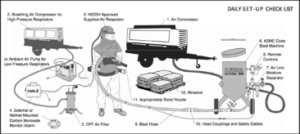Cleaning and preparation:
Cleaning and preparation is a process before applying a paint system for coating metal elements or before applying a concrete coating system.
The surface preparation process before the application of coating systems is of great importance in obtaining the resulting final result of the entire system. The surface preparation goals include cleaning and removing old coatings and / or existing rust, roughing up the foundation for mechanical anchoring of the foundation (primer) to create the best connection
The aggregate shape has significance in the field preparation process and can be divided into two families – grains in a jagged fashion are called ‘GRIT’ and grains in a circular shape are called ‘SHOT’. The different types of grains and their decomposition during the surface spraying create a different “roughness profile”, according to the coating specifications. In some cases, a shortened process called “sandwashing” can be performed, ie a low grain splash combined with a quick splash of the splash with the splash nozzle on the surface, a process designed to perform gentle and quick roughening (“shine lowering”) from the surface
Flushing at high water pressure and ultra high pressure:
Water pressure washes are common in surface preparation processes prior to application of the coating and coloring system. Pressure selection and type of flushing is done according to the technical specifications and needs of the project. Basic water pressure rinsing up to 350 bar is primarily intended for dust removal and contaminant residues including paint, rust, and plaster Water pressure rinsing up to 1000 bar is considered “high pressure rinsing” and allows the complete removal and cleaning of scrubbed and rust-coated coatings adhered to the substrate as well as creating a rough profile for concrete surfaces. This flushing requires the use of high pressure and high pressure dedicated pumps as well as a skilled worker with suitable protective equipment
Washing above 1000 bar is considered “Ultra High Pressure Washing” and is intended for the complete removal of multi-thickness coatings, controlled quarrying of plaster and concrete surfaces and is done with the help of dedicated and specially commissioned pumps for the task along with stringent safety regulations.particles are loosely placed on top of the substrate
Mechanical cleaning:
Where it is not possible or prohibited to perform abrasive cleaning in the spraying, manual mechanical cleaning is performed which includes the use of electrical or pneumatic mechanical (air pressure motor) and sometimes completely manual non-motorized means. The mechanical cleaning process and its results are equivalent to the abrasive spraying process and is also subject to a series of European and American standards (as mentioned in the previous section). This process involves scraping and rubbing the surface until you get a clean, rust-and-scrubbed .For the purpose of this process, there is a wide range of dedicated means including rotating steel brushes, wide chisels to remove rust blocks, papers and grinding heads (Shlake or Shliffe heads), Chipping devices (pneumatic pins) and standard and eccentric grinding devices Dedicated to these tasks.infrastructure, metal and steel roughness and even removing old coatings
In some cases, an ‘integrated flushing process’ can be used to introduce detergents, soaps and even abrasive materials into the water mixture to add or change the flushing process – according to project specifications. It should be noted that water pressure washes for metal elements do not substitute for roughness and create a renewed profile of the surface

